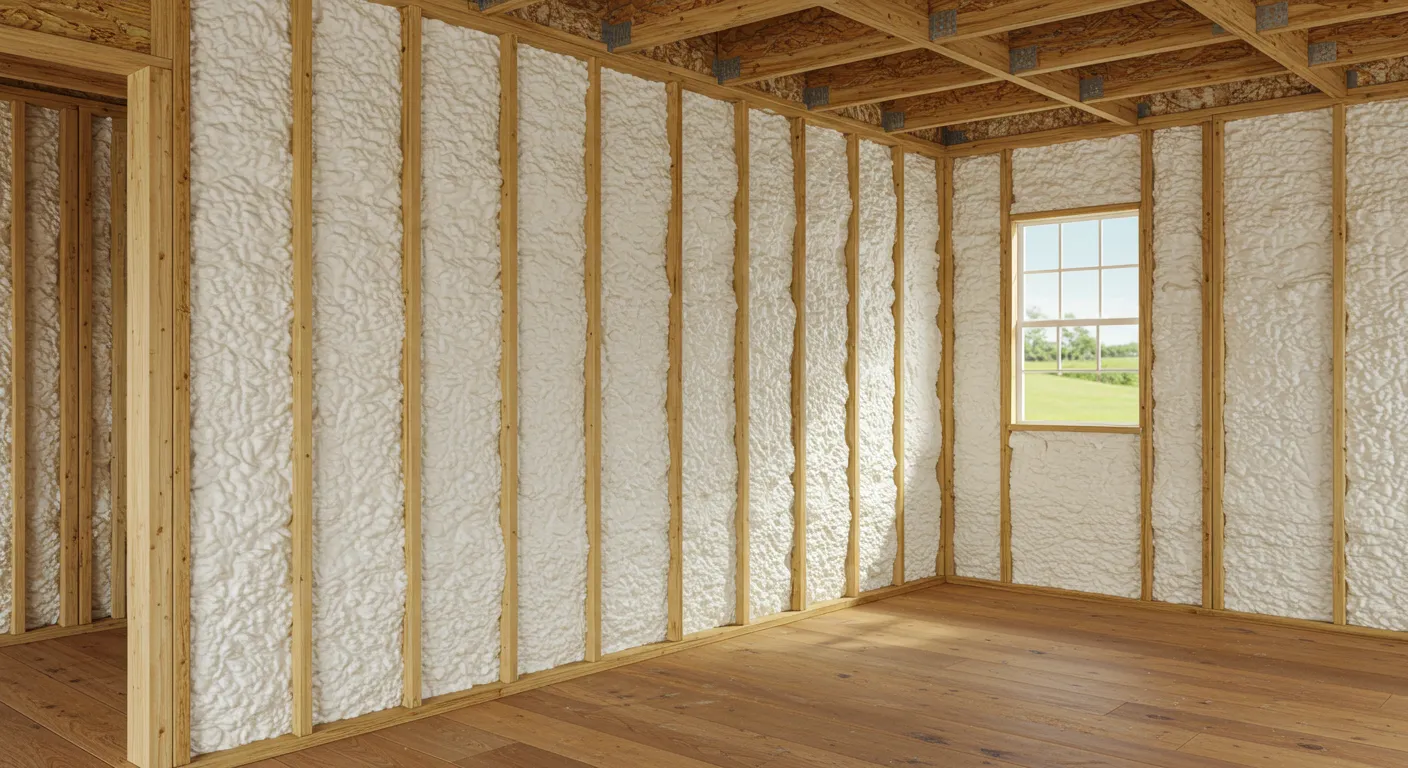R-value measures how well insulation resists heat flow. A higher R-value means better thermal resistance, which directly impacts energy efficiency. When selecting spray foam insulation, understanding R-value ensures the material meets local building codes and performs effectively in your climate.
Spray foam insulation varies in R-value depending on whether it’s open cell or closed cell. Closed cell foam offers higher R-value per inch and is more moisture-resistant. Open cell foam is lighter, expands more, and provides soundproofing. Choosing the right R-value depends on the building type, climate zone, and specific performance needs.
Polyco Spray Foam Insulation has extensive field experience across Louisiana, where high humidity and fluctuating temperatures require materials with dependable thermal and moisture control. This guide shares practical, data-backed insights based on direct installation outcomes.
R-Value Comparison of Spray Foam Types
| Foam Type | R-Value (Per Inch) | Moisture Resistance | Density | Air Barrier Capability | Soundproofing Quality |
|---|---|---|---|---|---|
| Open Cell Foam | R-3.5 to R-3.9 | Low | 0.5 lb/ft³ | Moderate | High |
| Closed Cell Foam | R-6.0 to R-7.4 | High | 1.75 – 2.2 lb/ft³ | High | Moderate |
[Image: Cross-section of open and closed cell spray foam in wall cavity]
Climate and Regional Considerations
In Louisiana’s Zone 2 and 3A climate zones, insulation must handle both heat and moisture. Closed cell foam performs well in humid conditions and provides added structural rigidity. Open cell foam can be used effectively in interior wall cavities where moisture is controlled.
Bonus Tip
Install closed cell foam in crawlspaces and attics prone to high humidity. Open cell works well in partition walls for sound dampening and minor thermal separation.
Technical Specifications of Spray Foam Insulation
| Specification | Open Cell Foam | Closed Cell Foam |
|---|---|---|
| Application Thickness | 3″ to 5″ (typical) | 1″ to 2″ (typical) |
| Vapor Permeability | 10 perms @ 3″ | <1 perm @ 1.5″ |
| Tensile Strength | ~5 psi | ~30-50 psi |
| Compressive Strength | ~1 psi | ~25-30 psi |
| Air Sealing Effectiveness | Good | Excellent |

Industry Data Points
- The U.S. Department of Energy reports that heating and cooling account for 49% of energy use in the average American home (DOE, 2023).
- According to the Insulation Institute, proper insulation can reduce monthly energy bills by up to 20% (NAIMA, 2023).
- Closed cell spray foam has been shown to increase structural strength by up to 300% (SPFA Technical Guide, 2023).
Things to Consider Before Making a Decision
- Climate zone: Higher humidity and temperature variation call for materials with stronger moisture control.
- Budget constraints: Closed cell is more expensive but provides higher R-value per inch.
- Application area: Attics, basements, crawlspaces often require different foam types than interior walls.
- Building codes: Verify local R-value requirements to ensure compliance.
- Long-term goals: Consider energy efficiency rebates and return on investment timelines.
Bonus Tip
In retrofit projects, ensure old insulation is fully removed before applying new foam to avoid thermal gaps and inconsistencies.
Most Relevant Services Offered by Polyco Spray Foam Insulation
- Spray Foam Insulation Contractor: Professional assessment and installation based on building structure and local climate needs.
- Closed Cell Foam Insulation: Ideal for moisture-prone areas, provides high R-value and structural support.
- Open Cell Foam Insulation: Suited for interior applications with soundproofing benefits.
- Soil Stabilization: Used to support foundational integrity and prevent shifting in insulation-supported structures.
Common Questions Before Making a Decision
How do I know which R-value I need?
Check local building code requirements for each part of the structure. Then match that to the foam type and thickness.
Can I combine open and closed cell foam?
Yes. Closed cell can be used for exteriors or moisture-prone zones; open cell is suitable for internal walls.
What if I already have fiberglass insulation?
Spray foam must be applied directly to surfaces. Old materials often need removal to avoid trapping moisture.
How thick should the spray foam be?
Thickness depends on target R-value and building location. Closed cell often requires less thickness than open cell.
Get Expert Insulation Guidance
Speak with a technician who understands the local climate and building requirements. Select insulation based on performance, not just price.
Polyco Spray Foam Insulation
Email: [email protected] Phone: +1 225-286-3546
FAQ Section
What is the lifespan of spray foam insulation?
With proper installation, both open and closed cell foam can last over 30 years without degradation.
Does R-value degrade over time?
Closed cell maintains its R-value well over time. Open cell may slightly degrade but still performs reliably if not exposed to moisture.
Can spray foam be applied in cold weather?
Yes, but installation conditions should be controlled. Foam must reach a certain temperature to expand correctly.
How does spray foam impact indoor air quality?
When installed correctly, it seals out allergens and outdoor pollutants, improving indoor air quality.
Is spray foam resistant to pests?
Closed cell offers resistance to rodents and insects because of its density and hardness.

